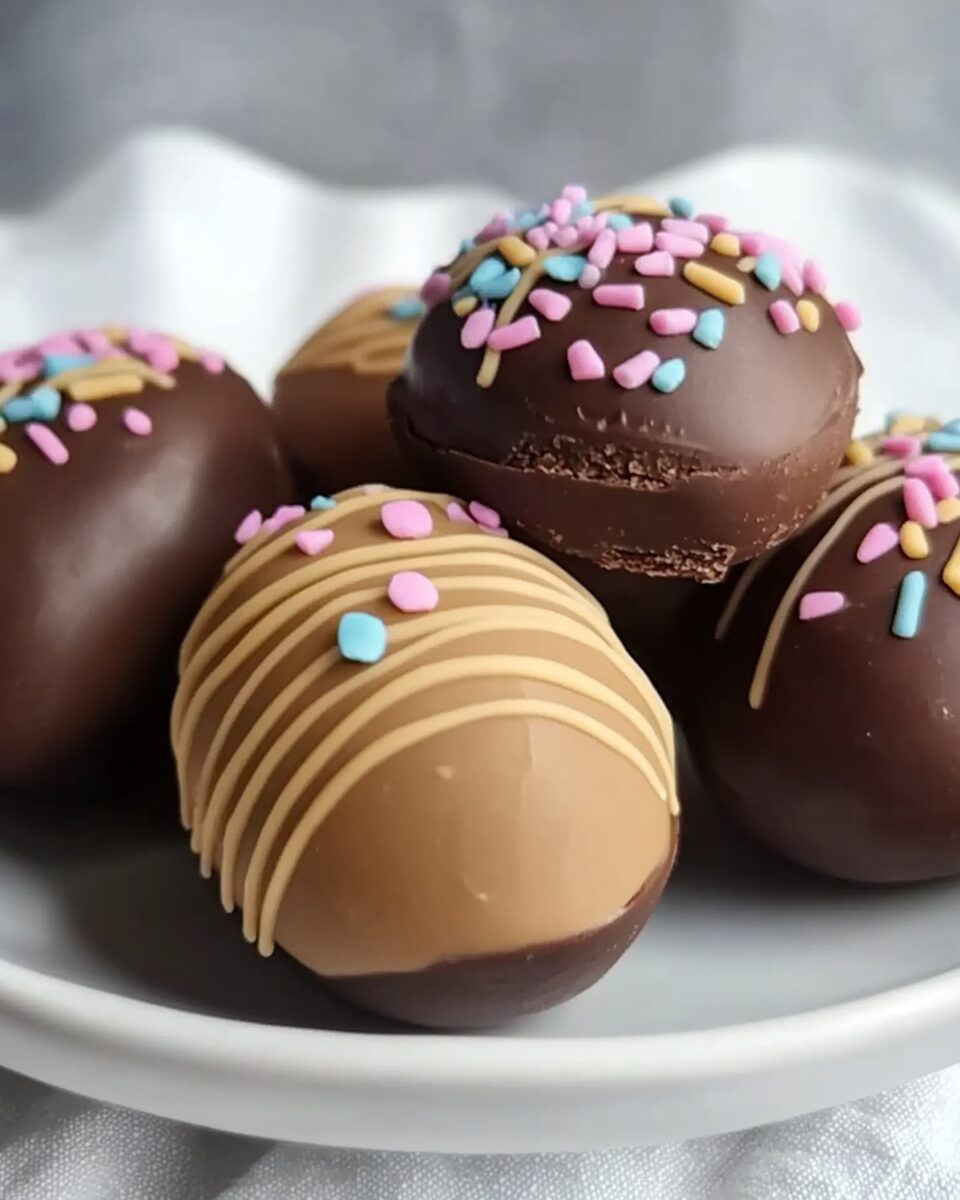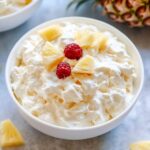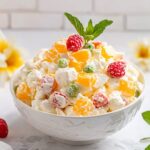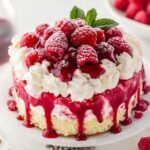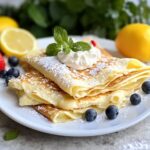Peanut Butter Eggs II is a sweet and creamy treat, perfect for Easter or any time you crave a rich, indulgent snack. With a delicious peanut butter center surrounded by a layer of chocolate, these homemade peanut butter eggs are sure to satisfy your sweet tooth. The recipe is simple to make, and the result is a delightful candy that can be enjoyed by kids and adults alike. They are a great alternative to store-bought chocolates and make a fun, homemade gift.
Full Recipe:
Ingredients
- 1 1/2 cups peanut butter
- 1/4 cup butter, softened
- 1 1/2 cups powdered sugar
- 1 teaspoon vanilla extract
- 3 cups semisweet chocolate chips
Directions
- In a medium-sized bowl, combine the peanut butter, softened butter, powdered sugar, and vanilla extract. Stir until smooth and creamy.
- Shape the mixture into egg shapes (about 1 inch long) and place them on a baking sheet lined with wax paper.
- Refrigerate the peanut butter eggs for 1 hour, or until firm.
- In a heatproof bowl, melt the chocolate chips in the microwave, stirring every 30 seconds until smooth.
- Dip each peanut butter egg into the melted chocolate, making sure it is fully coated. Return the eggs to the wax paper and refrigerate until the chocolate hardens, about 30 minutes.
- Store the peanut butter eggs in an airtight container at room temperature or in the refrigerator.
Nutrients
- Calories: 350 kcal per serving
- Fat: 22g
- Carbohydrates: 33g
- Protein: 6g
- Fiber: 3g
- Sugars: 27g
The History Behind Peanut Butter Eggs
Peanut butter eggs have been a popular confection for decades. Though their exact origin is unclear, they are widely believed to have gained significant popularity in the United States in the mid-20th century, largely due to the rise of candy manufacturers like Reese’s. The Reese’s Peanut Butter Cup, introduced in 1928, helped cement the combination of chocolate and peanut butter as one of the most beloved pairings in the candy world. As this duo became a household favorite, homemade versions of peanut butter eggs began to appear, especially during the Easter season.
Easter has long been associated with chocolate eggs, and the tradition of making peanut butter eggs during this holiday became a beloved activity for families. Homemade peanut butter eggs are often made with love and shared among loved ones, making them more special than store-bought varieties. Over time, the recipe has been refined and adapted, but the core ingredients—peanut butter and chocolate—remain the same.
Why Peanut Butter Eggs are a Perfect Easter Treat
Peanut butter eggs are perfect for Easter celebrations for several reasons. First, the egg shape is iconic and synonymous with the holiday. Traditionally, chocolate eggs are hidden in Easter egg hunts, and peanut butter eggs provide a delicious alternative to classic chocolate-filled eggs. They also make for excellent homemade gifts, whether given as a sweet treat in an Easter basket or as part of a celebratory meal.
Moreover, peanut butter eggs are an easy and fun project to do with kids or friends. The process of shaping the peanut butter mixture into egg shapes, dipping them into chocolate, and waiting for the eggs to set is a simple yet enjoyable activity that can be a memorable part of Easter traditions.
The Appeal of Peanut Butter and Chocolate
The combination of peanut butter and chocolate is a classic pairing that works so well because of the balance of textures and flavors. Peanut butter provides a creamy, salty contrast to the sweetness of the chocolate, creating a harmonious experience with each bite. The richness of the peanut butter is complemented by the smooth, melt-in-your-mouth chocolate coating, making the combination irresistible.
Additionally, this pairing appeals to a wide variety of taste preferences. Chocolate lovers will enjoy the decadence of the cocoa, while peanut butter fans will appreciate the creamy and nutty flavor. Together, they create a treat that is hard to resist.
Tips for Perfect Peanut Butter Eggs
While the recipe itself is straightforward, there are a few tips and tricks to ensure that your peanut butter eggs turn out perfectly every time.
-
Use High-Quality Peanut Butter: The peanut butter you choose can greatly affect the flavor of the eggs. Choose a creamy, unsweetened peanut butter for the best results. Avoid using natural peanut butter with oil separation, as it may not hold together as well in the mixture.
-
Properly Mix the Ingredients: When combining the peanut butter, butter, powdered sugar, and vanilla extract, make sure the mixture is smooth and well-blended. This ensures that the eggs have a uniform texture and consistency throughout.
-
Chill the Peanut Butter Eggs: After forming the egg shapes, it’s essential to chill them in the refrigerator for at least an hour. This helps them firm up, making it easier to coat them in chocolate without the peanut butter mixture becoming too soft.
-
Perfecting the Chocolate Coating: To achieve a smooth, glossy chocolate coating, make sure to melt the chocolate chips slowly, stirring frequently. You can also add a teaspoon of vegetable oil or shortening to the chocolate to give it a thinner consistency, making it easier to dip the eggs.
-
Storage: Peanut butter eggs can be stored in an airtight container at room temperature for up to a week. If you want to keep them fresh for a longer period, you can refrigerate them. Just make sure they’re fully cooled before storing to avoid condensation.
Creative Variations of Peanut Butter Eggs
The beauty of peanut butter eggs is their versatility. While the classic recipe is delicious on its own, you can experiment with different variations to suit your tastes or add a personal twist to the traditional treat.
-
Dark Chocolate Coating: While milk chocolate is a popular choice, dark chocolate can be used for a richer, slightly more sophisticated flavor. The bitterness of dark chocolate pairs beautifully with the sweetness of the peanut butter filling.
-
Add-ins to the Peanut Butter Filling: To enhance the flavor of the peanut butter filling, consider adding chopped nuts such as almonds, cashews, or peanuts. Dried fruit like raisins, cranberries, or cherries can also provide an interesting texture contrast and a burst of sweetness.
-
Peanut Butter Eggs with a Twist: For a fun twist, you can try adding flavored extracts such as mint, cinnamon, or almond to the peanut butter mixture for a unique flavor. Another option is to drizzle white chocolate on top of the eggs for an extra layer of flavor.
-
Gluten-Free and Vegan Options: If you have dietary restrictions, you can still enjoy peanut butter eggs. To make a gluten-free version, simply ensure that the chocolate used is certified gluten-free. For a vegan version, replace the butter with a plant-based alternative and choose dairy-free chocolate chips.
-
Decorating Peanut Butter Eggs: If you’re making peanut butter eggs for a special occasion like Easter, consider decorating them with colorful sprinkles, edible glitter, or a drizzle of colorful icing to make them even more festive and fun.
Health Considerations
While peanut butter eggs are undoubtedly delicious, they are also quite rich in calories and sugar. If you’re looking to make a healthier version, consider using dark chocolate with a higher cocoa content and reducing the amount of powdered sugar in the peanut butter filling. You can also experiment with using a sugar substitute or a natural sweetener like honey or maple syrup.
Additionally, peanut butter eggs offer some nutritional benefits. Peanut butter is a good source of protein, healthy fats, and essential vitamins and minerals. However, it’s important to consume these treats in moderation, as they can be calorie-dense due to the chocolate and peanut butter combination.
Conclusion
Peanut Butter Eggs II is a timeless homemade treat that is perfect for any occasion, but especially popular during Easter. With a simple yet flavorful combination of peanut butter and chocolate, these eggs are sure to impress your guests and satisfy your sweet cravings. The versatility of this recipe allows you to tailor it to your preferences, whether you want to experiment with different types of chocolate, add-ins, or creative toppings.

